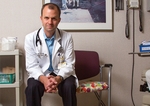business
Hospitals see some economic recovery
■ Financial numbers are looking better, but experts are concerned the industry has not yet seen the full force of the recession.
By Victoria Stagg Elliott — Posted Jan. 11, 2010
- WITH THIS STORY:
- » External links
- » Related content
Recent stock market gains, along with various steps taken to control costs, have strengthened hospital bottom lines, and several recent reports have painted a positive economic picture for the industry.
Many institutions, however, continue to have financial problems. And, experts say, health care finances are usually slow to dip in a downturn, so the full effect of the recession may not yet be realized.
"Investment income has come back, but we have so many patients who are uninsured or covered through government programs." said Bruce Rueben, president of the Florida Hospital Assn. "We're using investment income to subsidize operations."
One suggestion that recovery has arrived is offered by a research paper issued by Thomson Reuters' Center for Healthcare Improvement Nov. 9, 2009. It found that the median profit margin for a broad base of more than 400 hospitals had increased from 0.37% in the third quarter of 2008 to 8.4% in the second quarter of 2009. A greater number were in the black, and days of cash-on-hand increased. No significant differences were found based on institution size.
"U.S. hospitals are on track to come out of the recession in better financial shape than they were in when the downturn began," said Gary Pickens, PhD, chief research officer at Thomson Reuters and one of the study's authors.
The improved financial status was primarily achieved by restraints on money spent on staff, combined with improvements in hospital investment portfolios. Many institutions also improved their efficiency: Length of stays got shorter, with more money earned per patient discharge.
"Managing costs is extremely important, and hospitals have been successful in managing their labor expenses through this downturn," said Pickens.
Also, several recently issued papers have found that hospitals' borrowing ability is improving. An American Hospital Assn. survey of 768 hospital chief executive officers found that a larger number of hospital CEOs said access to capital was getting easier. Another issued by Moody's Investors Service Inc. found the bond ratings of 20 nonprofit hospitals and health systems had been upgraded in 2009. Standard & Poor's also identified health care as one of three sectors that most likely will see credit ratings go up in 2010.
High credit ratings are important because they make capital easier to access, at a lower interest rate.
There are many signs, however, that not all institutions are experiencing recovery, and that future financial health remains uncertain.
"A lot remains to be seen," said Matt Fenwick, American Hospital Assn. spokesman. "We know hospitals were deeply affected by the economic slowdown. Nationally some economists are pointing to signs of recovery, but many still believe that improvement will be slow, with some setbacks along the way. With high unemployment and states facing budget deficits, hospitals will continue to face tough financial pressures and difficulties meeting the needs of their communities."
The report from Thomson Reuters found 20% of hospitals were financially in the red, although this is comparable with the numbers before the recession began in December 2007 and a vast improvement over the 50% in the red in the third quarter of 2008. Also, while Moody's increased the ratings of 20 institutions, the hospital industry as a whole is expected to have more downgrades than upgrades, something that has been true for 16 of the past 20 years.
"Twenty upgrades is not a lot," said Lisa Goldstein, senior vice president and team leader for health care ratings at Moody's. "Credit is improving for some hospitals, but hospitals are complex and a little bit different from other businesses. People show up at a hospital without being able to pay. Nobody shows up at an airport not being able to buy a ticket."
In addition, hospitals may not yet have felt the worst of the economic downturn because health care is traditionally an economic indicator that trails behind others, experts said. It is unclear what kind of impact health system reform will have, and several state hospital associations are sounding the alarm about the strain caused by cuts to state health programs.
Higher rates of unemployment and large numbers of people running out of COBRA coverage mean more use of public health services, but reimbursements are being slashed by strapped state governments.
For instance, the Healthcare Assn. of New York State released results of a survey of more than 100 hospitals in that state that documented the impact of $3.87 billion cut from health care in the various state budgets running from January 2008 until December 2010. The cut, combined with a reduction in demand for elective procedures, meant that 17% of hospitals were eliminating or reducing services. Also, 63% had frozen hiring or wages, and 10% had problems meeting payroll.
"There are certainly some bright spots out there, but the majority of our members are worried about how they are going to meet community demands," said Bill Van Slyke, spokesman for the organization.












